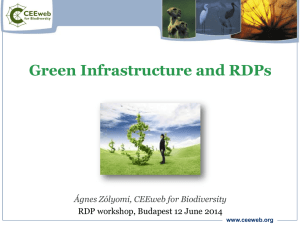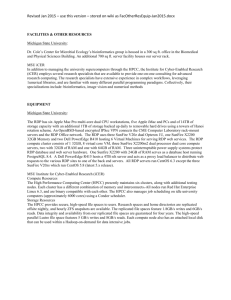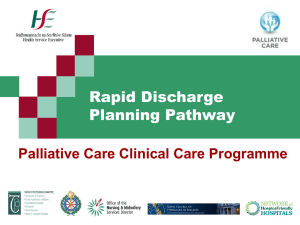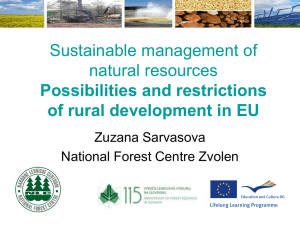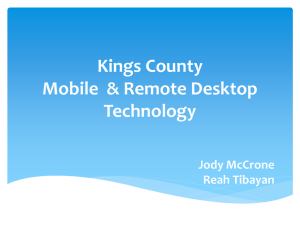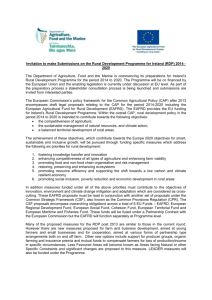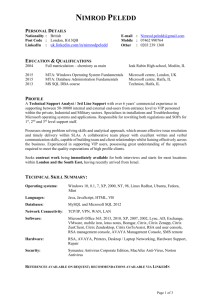Challenges of SEA in regional planning in Sweden
advertisement
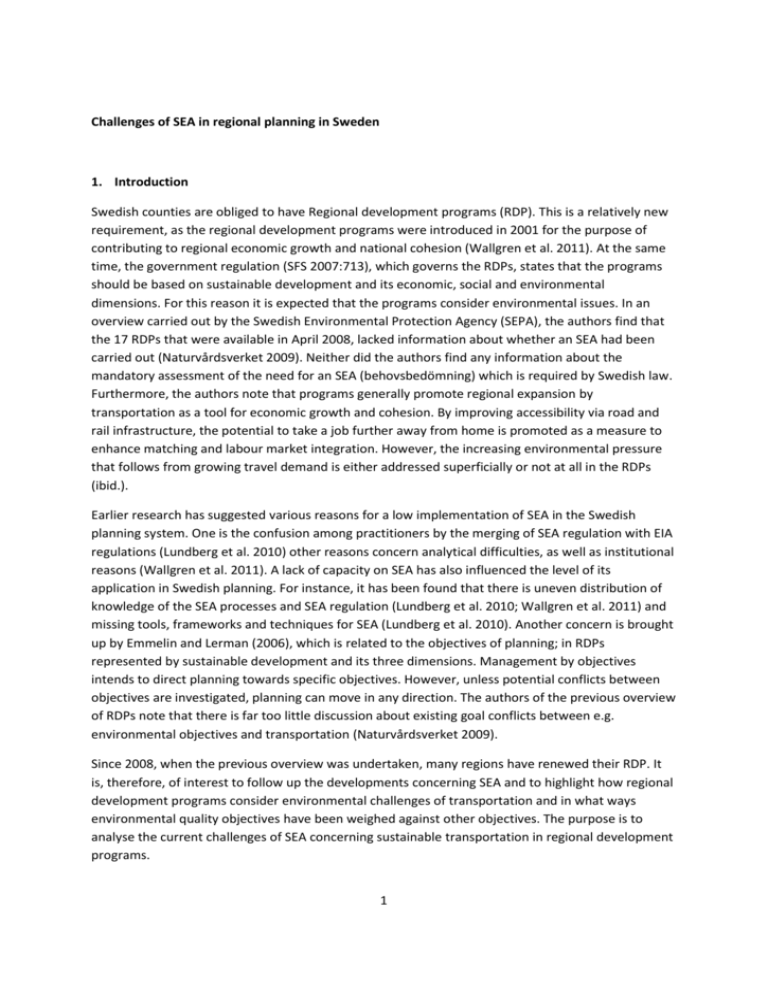
Challenges of SEA in regional planning in Sweden 1. Introduction Swedish counties are obliged to have Regional development programs (RDP). This is a relatively new requirement, as the regional development programs were introduced in 2001 for the purpose of contributing to regional economic growth and national cohesion (Wallgren et al. 2011). At the same time, the government regulation (SFS 2007:713), which governs the RDPs, states that the programs should be based on sustainable development and its economic, social and environmental dimensions. For this reason it is expected that the programs consider environmental issues. In an overview carried out by the Swedish Environmental Protection Agency (SEPA), the authors find that the 17 RDPs that were available in April 2008, lacked information about whether an SEA had been carried out (Naturvårdsverket 2009). Neither did the authors find any information about the mandatory assessment of the need for an SEA (behovsbedömning) which is required by Swedish law. Furthermore, the authors note that programs generally promote regional expansion by transportation as a tool for economic growth and cohesion. By improving accessibility via road and rail infrastructure, the potential to take a job further away from home is promoted as a measure to enhance matching and labour market integration. However, the increasing environmental pressure that follows from growing travel demand is either addressed superficially or not at all in the RDPs (ibid.). Earlier research has suggested various reasons for a low implementation of SEA in the Swedish planning system. One is the confusion among practitioners by the merging of SEA regulation with EIA regulations (Lundberg et al. 2010) other reasons concern analytical difficulties, as well as institutional reasons (Wallgren et al. 2011). A lack of capacity on SEA has also influenced the level of its application in Swedish planning. For instance, it has been found that there is uneven distribution of knowledge of the SEA processes and SEA regulation (Lundberg et al. 2010; Wallgren et al. 2011) and missing tools, frameworks and techniques for SEA (Lundberg et al. 2010). Another concern is brought up by Emmelin and Lerman (2006), which is related to the objectives of planning; in RDPs represented by sustainable development and its three dimensions. Management by objectives intends to direct planning towards specific objectives. However, unless potential conflicts between objectives are investigated, planning can move in any direction. The authors of the previous overview of RDPs note that there is far too little discussion about existing goal conflicts between e.g. environmental objectives and transportation (Naturvårdsverket 2009). Since 2008, when the previous overview was undertaken, many regions have renewed their RDP. It is, therefore, of interest to follow up the developments concerning SEA and to highlight how regional development programs consider environmental challenges of transportation and in what ways environmental quality objectives have been weighed against other objectives. The purpose is to analyse the current challenges of SEA concerning sustainable transportation in regional development programs. 1 In a first step document studies were carried out. Nine RDPs were chosen among the 21 counties in Sweden. The sample of RDP documents cover counties with different prerequisites concerning geography and population. In the second step, three counties were selected for in-depth interviews. The three included counties are the County of Gävleborg (about 100 kilometres north of Stockholm), the County of Västerbotten (in the north of Sweden) and the County of Västra Götaland (on the West Coast, including Sweden’s second largest city; Gothenburg). A common feature is that all three counties have an RDP that has been approved during the past few years, thus increasing the probability that those who were in charge of co-ordinating the work of the RDP process are still working at regional authority and remember details of the process. Furthermore, while the RDP of Gävleborg had a stronger and Västerbotten a weaker environmental profile, this factor provided further reason for the choice of these two counties. Next section, section 2, provides a short description of the role of the RDP of the Swedish planning system. Section 3 presents the results of the document study and how sustainable transportation has been dealt with in the RDP documents. Section 4 highlights the results of the interviews and section 5 concludes the paper. 2. The Swedish planning system The Swedish planning system is governed by strong local level governance. By tradition, Swedish municipalities have a relatively strong position. The constitution states that Swedish democracy is implemented by a parliamentary system of government and through local self-government. The regional planning level has not been very well developed and represents the weakest tier. Governance in Sweden has been described as an hour-glass where the regional level is the waist, with weaker mandate and powers than at the national or the local levels (Pettersson, 1998). In the planning system, the RDPs are strategically oriented umbrella documents for other regional and local programmes and plans, providing input to e.g. structural funds programmes and comprehensive plans at the municipality level. The idea behind the RDP is to join the forces of the many public and private actors on the local, regional and national level of importance for regional development through formulating common objectives and strategies. As a result, the process of the RDP is based on consensus-building within the partnership (Wallgren et al. 2011). The government’s guidelines state that the RDP should be a uniting strategy of regional growth in one or several counties (SFS 2007:713). 3. SEA and sustainable transport in RDP documents In 2004 with the implementation of the European directive on environmental assessment of certain plans and programmes, SEA became compulsory for planning and programming. This means that an SEA should have been carried out in a process parallel to that of the RDP, or if not the motivation why the RDP does not have significant environmental impact (behovsbedömning) needs to be publicly available. The document studies, covering nine Swedish regional development plans, provide no information about the application of SEA. This observation is in line with that of the previous 2 overview (Naturvårdsverket 2009). Searches on the internet using the name of the mandatory document (behovsbedömning), give only one hit, and concerns the regional development plan of Stockholm County, which is governed by other legislation. In order to identify sustainable transport, it is possible to use the work of e.g. Banister (2008) as a starting point. According to Banister (2008) sustainable transport requires actions to reduce the need to travel (less trips), to encourage modal shift, to reduce trip lengths and to encourage greater efficiency in the transport system. Several regional development programs focus on the development of public transport and bicycle. It is also common for RDPs to suggest modernisation and improvement of the broad band infrastructure. Another common emphasis of the RDP documents is to point out the need for improved train transportation in order to enhance inter-county transport. In those RDP documents that mention international accessibility, this is largely related to enhancement of air transport. Two RDPs discuss rural transportation and the need to improve accessibility by road (Gotland and Värmland). Several RDP documents mention strategies to substitute fossil fuels with renewable fuels. The county of Gävleborg goes one step further by formulating a goal of renewables in the transport sector at 20 percent by 2020. This is double the level of the goal set by the EU of 10 percent renewable fuels in transport by 2020. These observations suggest that the regional development programs have significant focus on sustainable transportation. Measures to reduce the demand for transport include urban planning that aims at dense and mixed urban areas. However, only two of nine RDPs mention integration between land-use and transportation. The RDP of Värmland proposes a holistic approach by enhanced interaction between transport and urban planning. One of the goals of the RDP of Östergötland is sustainable use of natural resources. This is described as integration between urban development, transportation and technical systems in order to minimize the environmental impact. There is almost no discussion about goal conflicts between transportation and the environment. The exceptions are Gotland and Gävleborg. The RDP of Gotland points out that the transport system has positive impacts on sustainable economic and social developments, but is in conflict with ecological perspective. The RDP of Gävleborg considers all three dimensions of sustainable development. Unless all of them evolve in the right direction, development cannot be judged sustainable. According to the RDP of Västerbotten the transport sector is the largest source of emissions in the county. 4. Interviews The informants of Västra Götaland and Västerbotten explain that they did not distinguish any major conflicts of objectives during the process of preparation of their RDP. In discussions, it happened that goal conflicts became apparent, but according to both informants, these were solved in the dialogues between the actors participating in the RDP process. In Västerbotten, they had prepared for goal conflicts by appointing a working group for handling trade-offs. A traditional goal conflict in northern Sweden is between transport infrastructure and Sami communities, but this conflict did not occur. There were also discussions about the environment and transport and this led to priorities concerning environmental measures at airports. 3 According to the interviewee of Gävleborg, they distinguished a potential goal conflicts between economic growth and other aspects of the sustainability framework. It was perceived that economic growth is the principal interest in planning, unlike e.g. gender and environmental issues. This led to the choice of not focusing on economic growth in the RDP, and instead concentrating on the other two dimensions of sustainability. Since no SEA had been carried out in the three counties, another topic of discussion was whether environmental assessment is a tool that can be used in the process of producing regional development programs and whether it can deliver concrete benefits for the environment. In one county, however, the informant was not aware of the tool. This was probably due to division of labour during the preparation of the RDP. Environmental issues were delegated the responsibility of the environmental secretariat. The other interview responses suggest that there is a mix up between SEA and EIA. One informant pointed out that the tool is applicable to assess the impacts of concrete actions, which do not exist in a regional development strategy. “The regional development strategy is a broad and comprehensive approach that is neither linked to physical action or any spatial dimension”. Another view was that an SEA of the RDP would require substantial resources and would be technically difficult to carry out. The first informant pointed out that on a general level, the driving force of the RDP is not to achieve environmental objectives. According to this view the environmental issues of RDPs should be to certify that the strategies do not to affect adversely the environmental objectives. 5. Conclusions The document studies of a selection of nine Swedish regional development programs suggest that very little has happened since the previous overview done in 2008. As in 2008, no information was found about the use of SEA on RDPs through document studies. The in-depth interviews further suggest that SEA is not undertaken. Another obstacle when it comes to environmental impact of RDPs is potential conflicts between objectives. Unless conflicts of objectives are highlighted, the environmental dimension might be lost. Document studies imply that conflicts between objectives are either superficially treated or not handled at all. The interviews, however, provide some further insights suggesting that, at least in one case, there is preparedness to devote resources to systematically analyse trade-offs, but in practice, goal conflicts were solved in discussions. Additionally, the interviews imply that there is lack of knowledge of SEA and that planners mix up SEA and EIA. The notion of analytical difficulty of carrying out an SEA was also observed in interviews as one informant stated it is technically difficult to apply the tool to an RDP. 4 References Banister, D. (2008) The sustainable mobility paradigm, Transport Policy 15, 2, 73 – 80. Lundberg K, Balfors B, Folkeson L and Nilsson M (2010). SEA monitoring in Swedish regional transport infrastructure plans—improvement opportunities identified in practical experience Environ. Impact Assess. Rev. 30 400–6 Naturvårdsverket (2009) Environmental issues in regional development programs [in Swedish Miljöfrågor i de regionala utvecklingsprogrammen, en sammanfattande analys] Report 5869, February 2009. Nilsson M, Wiklund H, Finnveden G, Jonsson D K, Lundberg K, Tyskeng S andWallgren O (2009). Analytical framework and tool kit for SEA follow up Environ. Impact Assess. Rev. 29 pp.186–99. Pettersson, O (1998). Statsbyggnad: den offentliga maktens organisation, Stockholm, SNS Studieförbundet Näringsliv och Samhälle. SFS 2007:713 Government regulation on regional growth [in Swedish Förordningen om regionalt tillväxtarbete]. Wallgren, O., Nilsson, M., Jonsson, D.K., and Wiklund, H. (2011). Confronting SEA with real planning: the case of follow-up of reigonal plans and programes in Sweden. Journal of Environmental Assessment Policy and Management, 13, 2, pp. 229-250. 5
